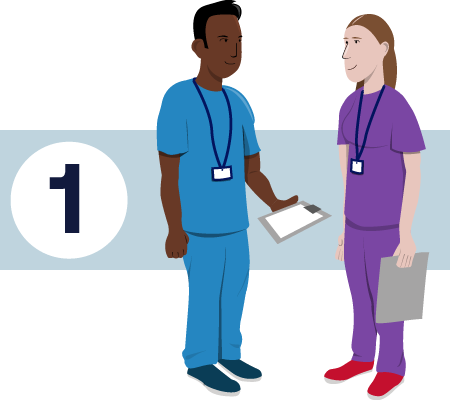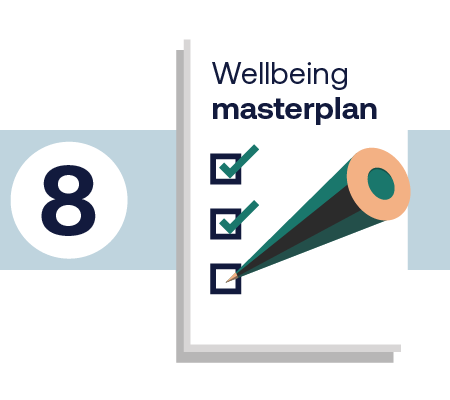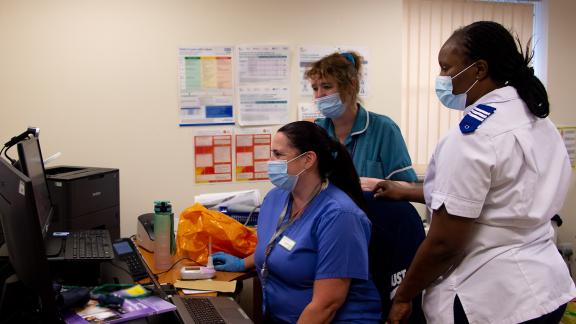This page was created in collaboration with, and to support, NHS leads in health and wellbeing, staff experience, human resources, equality, diversity and inclusion, as well as reward and recognition, and freedom to speak up guardians.
These eight elements outline the critical steps and considerations for achieving a robust and sustainable staff experience programme or initiative. It will also support NHS organisations to realise the aspirations outlined in the Long Term Workforce Plan and the NHS People Promise.
Eight elements poster resource - This guidance is accompanied by our eight elements poster, summarising all the key points for you to download, print and share within your organisation.
Culture, leadership and management
Create an inclusive, compassionate and supportive culture

An inclusive culture means celebrating and embracing our differences and providing the opportunity for everyone to have a voice and make positive contributions. It is about ensuring everyone feels physically and psychologically safe. Organisations need to be clear and transparent about what this looks like in practice, and how to make it a reality for all employees.
A leadership culture where compassion and support are demonstrated, and wellbeing is prioritised is vital in enabling staff to engage and prioritise their own wellbeing. Leaders should model positive behaviours such as openly challenging stigmas and dispelling myths which segregate and marginalise individuals.
Sharing personal experiences, being curious and talking about taboo subjects normalises the conversation and encourages staff to seek help should they need it.
Recruiting a diverse board with a mixture of backgrounds, skills and experiences is a good way to embed inclusivity at a senior level and have top-down influence on inclusive practices within the organisation.

Actions and resources
- Our equality, diversity and inclusion web pages support NHS trusts to create a fairer and more diverse workplace. Encourage your organisation to become part of the Diversity in Health and Care Partners Programme.
- Use our Do OD pages to help you navigate culture change.
- The Equality, Diversity and Inclusion Group (EDIG) has published Building disability inclusive workplaces guidance on supporting colleagues with a disability.
- Our blog from Michael West on recovery and renewal shows how leaders can compassionately support their NHS staff.
- Read how Sheffield Children’s NHS Foundation Trust reflected the diversity of the community in their leadership team.
Influence your board-level leaders
Gaining support for your staff experience agenda at board level is crucial to fulfilling the aims of your strategy and/or initiative and ensuring staff experience is at the heart of your organisational strategy.
Forming constructive relationships with your board-level representative is key to achieving this. This could be your health and wellbeing guardian, HR director or someone who champions staff experience and sits on the board.
Ensure you keep these colleagues in the loop about any challenges, how you intend to address them and the support you need to make it a lived reality.
Highlight positive achievements and key developments in your programme to demonstrate the positive changes you have made in the organisation and the impact this has had on the workforce.
Encourage your leaders to challenge assumptions about the way work is done, why it is done that way and to promote trialling new ways of working.

Actions and resources
- Health and wellbeing leads may benefit from our get your board on board with health and wellbeing priorities guidance.
- Our Dear Matilda podcast is a great example of how great leadership turned around the Isle of Wight NHS Trust.
- Review our resources for supporting your health and wellbeing guardians and understanding their role.
- Access our guidance on board buy in to support the rising cost of living.
You may also want to read:
- our top tips for supporting the psychological safety of staff
- top tips on how to create a workplace speaking up culture which supports health and wellbeing
- how North East London NHS Foundation Trust created an inclusive organisational culture.
Recruit an effective staff experience lead
It is important to make sure you have an effective staff experience lead who can drive the agenda forward. Your lead may coordinate specific areas of staff experience or your entire staff experience programme.
This lead needs the right tools, training, experience and support to allow them to make a positive difference. Develop their stakeholder management skills, including their ability to influence at a board level, and consider offering opportunities such as secondments and training to enhance knowledge in areas of staff experience and healthcare settings.
Where possible, you should embed introductions to staff experience leads into your induction programme to raise the profiles of your leads within the organisation. It is also crucial that the wider organisation knows who your staff experience lead is and understands the role they play and the support they can offer.
Recruiting staff experience leads from different industries and backgrounds can bring new perspectives and increase diversity.

Actions and resources
- NHS England commissioned four Health Innovation Organisations to identify the development and support needs for health and wellbeing staff in collaboration with NHS organisations. Access the Developing NHS health and wellbeing leads report for more information.
- Encourage leads to use evidence-based strategies in their approach. Read our article on evidence-based approaches to workforce wellbeing.
- Support them to lead improvement within the trust, shifting mindsets from firefighting to continuous improvement. Read NHS England’s leading improvement guide for more information.
Upskill your line managers
Your line managers significantly influence employee attitudes and behaviours and can impact the success of your staff experience strategy. They are often the eyes and ears for how staff feel on the ground. Line managers should be trained in relevant policies and procedures and know where to signpost their staff for information and support.
Managers should also be empowered with the right resources. Keep information clear, digestible and easy to access to avoid overwhelming them. Collaborating with managers to create guidance and toolkits can help you effectively position these.
The Chartered Institute of Personnel Development (CIPD) outlines the crucial role that managers play in supporting employee wellbeing and engagement. Managers need to demonstrate supportive behaviours towards their staff, so they can address staff experience challenges before they escalate.

Actions and resources
- Support your line managers at work and keep them well. Emphasise that self-care is as important as caring for their staff and patients.
- Upskill managers and empower them to have open and honest conversations with their staff and demonstrate compassionate leadership. Utilise our health and wellbeing conversations guidance and compassionate leadership blog to support you.
- Ensure your managers are aware of and implement inclusive management styles through effective equality, diversity and inclusion training.
- Support line managers to communicate the reward offer to their employees and provide opportunities for staff to take advantage of benefits such as flexible working.
- Training and development provides a range of advantages to an employee, including career progression, improved confidence and new skills. There are also multiple advantages for the employers, which can be found on our cost of living investment and upskilling line manager web page.
- The NHS England expectations of line managers in relation to people management framework supports leaders and managers in embedding Our Leadership Way and Our NHS People Promise, with the ultimate goal of addressing the objectives set out in the NHS Long Term Workforce Plan.
Organisation-wide plan
Develop a clear vision

Outline your vision for your initiative or programme and consider how it relates to the wider organisational goals and values. Think about how your vision may impact staff and use this to guide how you communicate it to your audience.
Are you expecting a push back? How would you address it? Are you influencing board-level leaders or presenting to the staff it is likely to affect? Your approach should be clear, consistent, realistic and evidence-based to gain maximum support.
Working at a system level means organisations can share expertise and learn about what others are doing. This means better experiences for patients and staff. It is also important that staff and patients are part of the local community. Looking after your community will have a positive impact on population health outcomes.
Create a comprehensive strategy
Compile all the activities of your program, explaining how each contributes to the overall strategy. This will help the board and staff understand the purpose of the activities and consider ways they can contribute to its success. Make sure to be flexible in your approach so that you can add new activities or adjust those that are not meeting the needs of the staff.
Set robust, measurable objectives
When setting objectives, consider how they will contribute to the overall aims of your programme and how you will measure performance. The objectives should be clear, provable and relevant to your role and the remit of your strategy. Keep in mind that achieving objectives can be dependent on factors outside your control, such as the availability of certain resources.
Your objectives must be realistic and achievable, and you have to consider how you will overcome barriers or alternative approaches if your initial plan is not successful. Setting clear and robust objectives is also important in your evaluation, as it helps you to define and measure success.
Know your data
Identify all useful data sources

You can use a variety of metrics to measure staff experience in your organisation. This will allow you to adopt an evidence-based approach when formulating your strategy. It is important to identify which data sources are useful and what impact each metric has on staff and patients.
Consider whether you need to talk to staff about key metrics to fully understand the context and the impact this is having. For a more accurate indication of how staff are feeling, use multiple data sets to build an overall picture. For example, looking at occupational health referrals, in conjunction with absence rates, may help you make informed decisions on how to best support staff.
You could also consider data-driven improvement tools such as the model health system, which provides benchmarked insight and identifies areas for improvement for acute, community and mental health trusts.
Ensure your data is accurate and up to date
Having up-to-date, real-time data is important in gaining an accurate picture of what is happening in your organisation. Make sure managers know how to log data on the electronic staff record (ESR) system accurately and that you are collecting the right data at the right time. You can also use regular pulse surveys to get a snapshot of data on how your staff are feeling and if this changes over time.
Due to the rising cost of living and its negative impact on staff, NHS organisations have been reviewing their current reward and benefit offers. Using a data-driven, evidence-based approach, they have been able to implement additional financial measures to help staff navigate through these challenging times.
Gain insight into staff needs
Once you understand the needs of your staff you can develop effective plans for addressing the specific issues within your organisation. The best approach is to ask staff directly and identify key trends in responses. Work with the wider multidisciplinary team to understand how any gaps in staff needs can be met. Remember that basic staff needs should always be at the top of your agenda.

Actions and resources
- Explore the NHS staff survey results to guide you, considering what your local results suggest about your staff needs.
- Embed the Workforce Race Equality Standard (WRES) and Workforce Disability Equality Standard (WDES) data into your organisation.
- Our evidence-based approaches to workforce wellbeing page details evidence of workforce wellbeing and provides a useful basis for reviewing your approach.
- Prioritise staff needs effectively using our NHS staff wellbeing needs poster.
Understand your demographics
Gain an understanding of your staff demographics across the organisation so you can create a plan which represents your entire workforce. This can also help you tailor your approach and interventions to ensure they are as effective as possible.
Creating a safe space for staff to disclose disabilities, sexualities and other data related to protected characteristics can help you gain insight into how best to support your workforce. Ensure you only collect data that you need, complying with GDPR. You may want to explore any hesitancy to disclosing such information, to understand if it is deeply rooted in organisational culture, the reasons for this and how you can address it.
Read our guide to improving staff disability data and learn how Sussex Partnership NHS Foundation Trust improved their declaration rates.
Communication
Adopt clear messaging

Use simple language and clear messages to ensure all staff can engage with your initiative or strategy. Avoid overusing jargon and abbreviations as this may exclude potential readers. Outline why the message you are communicating is important and how it impacts your audience.
Take inspiration from our health and wellbeing communications guide.
Choose the right communication channels
Everyone digests information differently and accesses it in different ways. Consider the demographics in your organisation and how your target audience tends to best respond to your communication methods. Some may prefer electronic methods, while others like to receive information face-to-face.
Present sensitive topics in a sensitive manner. For example, some staff may feel uncomfortable speaking openly about menopause, so you could set up a menopause networking group where vital information can be shared in a safe space.
Ensure you are as inclusive as possible, including hard-to-reach groups such as frontline workers who may not have access to email when treating patients. You should also be as inclusive as possible to those with disabilities. Offer a variety of formats, such as braille, audio descriptions, or alt text when talking about images, and consider the font and contrast so what you are saying is easy to read. Collaborate with your EDI teams and staff networks to support you in this.

Actions and resources
- Check out our pay, pensions and reward pages to find out how you can use Total Reward Statements, and the reward web page template to communicate your reward offer.
- Read our flexible working enablers for change web page to learn how the FlexNHS movement was established to create a supportive, encouraging and resourceful network to promote and enable flexible working for everyone in the NHS. The campaign was used to generate more conversations about the benefits of flexible working and dispel any myths.
Develop a recognisable staff experience campaign
You could consider developing a staff experience campaign to support recognition and promotion of this work, adopting identifiable logos, branding and terminology to represent the work you are doing across the trust.
It’s helpful to have all your resources and support in one online hub while ensuring that online content is accessible in other formats for those who may not have access. This also helps you to formulate all your activities into one strategy.

Actions and resources
- Read our flexible working enablers for change web page to learn how the FlexNHS movement was established to create a supportive, encouraging and resourceful network to promote and enable flexible working for everyone in the NHS. The campaign was used to generate more conversations about the benefits of flexible working and dispel any myths.
Provide regular updates
Update your staff regularly on the progress of any new initiatives or changes to existing ones. Showcase where possible how you have implemented the changes asked for, as this will help to ensure continued engagement/feedback and support for your initiatives.
Engagement
Listen to your staff

Engage your staff by consulting them directly on what they want and need. This is vital to delivering a robust staff experience programme that meets staff needs. You can learn more about effective staff engagement on our web pages.
Gather real-time data through alternative channels. This could be by creating a safe space within staff networks where people can share personal experiences and views. This can help uncover hidden staff experience challenges, as well as encourage disclosure of personal information, such as disability.
Make sure everyone is empowered with the opportunity to share their views, and you can spot gaps in the appropriate support available. Also, ensure you act on what you have heard and demonstrate that you follow up on areas of concern where possible.
Actions and resources
- Read our guide to improving disability data and our case study on how the University of Morecambe Bay NHS Foundation Trust engaged with their disabled staff through effective listening.
- Read about how Liverpool Women's NHS Foundation Trust turned around its staff survey results through improved staff engagement, a focus on feedback and a major cultural shift.
- Read the NHS Staff Council Equality, Diversity, and Inclusion Group’s good practice guide to improving staff equality networks through partnership working.
- In our Staff engagement and retention - squaring the circle blog, you can hear about how focusing on staff engagement can help support the retention of your NHS workforce.
- Having a clear process in place to allow employees to share concerns is also vital. Take a look at the employer actions you can take to ensure staff have the freedom to raise concerns.
- Read our case study which explores how Lancashire Teaching Hospitals developed a tool to help improve staff engagement and empower line managers.
- Our case study from The Queen Elizabeth Hospital (QEH) King’s Lynn NHS Foundation Trust explores how it applied staff engagement methods to improve its NHS Staff Survey scores.
Engage with key stakeholders
There are lots of people across your organisation who might get involved in your staff experience programme. Where possible, engage with the occupational health team, physiotherapy service, communications, human resources, learning and development, public health, finance, clinical leads and anyone else who might have a part to play. You could also work with your local community to make the best use of the public services available to support staff.
Actions and resources
- Consider recruiting cultural ambassadors and champions in staff engagement, health and wellbeing and equality and diversity to support your strategy.
- Read how Yorkshire Ambulance Service NHS Trust introduced initiatives to improve engagement and staff experience in the workplace through recruiting cultural ambassadors and establishing staff equality networks.
Involve and engage staff union reps
Work with your trade union reps to develop and implement your staff experience strategies and policies. You can read more about working effectively with trade unions on the Social Partnerships Forum (SPF) website.
The NHS Staff Council’s Health, Safety and Wellbeing Group (HSWG) works in partnership to support compliance with health and safety legislation and the raising of standards of NHS workplace health, safety and wellbeing. The group promotes a safer working environment for all staff by promoting partnership working between employers and trade unions and promotes best practice across the NHS and independent sector.
The Equality, Diversity, and Inclusion Group (EDIG) is a technical group of the NHS Staff Council and works to deliver the equality agenda. The group comprises of employer and trade union representatives from across the NHS and wider healthcare sector. The EDIG works in partnership and prepares an annual work programme which is agreed by the executive of the NHS Staff Council.
Take a preventative approach
Look ahead

Embedding healthy, preventative behaviours in your organisation can often help negate future challenges. This could be ensuring all staff have anti-racism training as part of their induction and ensuring that staff are aware of time-sensitive reward incentives, such as deadlines for buying and selling annual leave.
Often, it is impossible to predict unforeseen circumstances, however investing in your staff experience initiative creates an environment that supports staff and builds a safe space for an organisation to thrive.
Our staff experience web pages have information and resources to help you retain your talented staff through a positive and supportive workplace experience.
Encourage collective responsibility for a positive staff experience
Make it clear that creating a positive staff experience is everyone’s responsibility. Working collaboratively and in a multidisciplinary team can ease the pressure on individual teams and helps consider the breadth of staff experience overall. Senior managers should also be expected to exemplify and promote positive behaviours and effectively support their staff.
Empower your staff to take some ownership of their staff experience. Working in a busy environment means that staff may not take the time to engage with many staff experience initiatives. Create a culture where staff are listened to can motivate them to take some personal responsibility for their experience at work.
Actions and resources
- Read how Imperial College Healthcare NHS Trust established a multidisciplinary wellbeing group with both clinical and non-clinical staff members to share intelligence and sense-check interventions.
- Encourage staff to approach their line managers openly and honestly about their personal needs. This could be through wellbeing conversations.
- Promote the flexible working opportunities available to staff; use our supporting staff to work flexibly infographic to engage these conversations.
- Educate your staff about self-compassion at work.
- Embed a culture that allows staff to speak up without prejudice and ensure they are listened to. Use our freedom to speak up guidance for managers and employers actions to support your organisations.
Initiatives
Take a targeted approach to identified challenges

Target your initiatives to best support your staff. You can use your data to learn where any hotspots are and learn from good practice in the areas that are doing well. Ensure you consider the impact and potential barriers of your initiatives and be mindful that particular staff groups may need more support than others.
Use networking opportunities to learn what other organisations are doing in the area/s you want to target.
Actions and resources
- See how North East Ambulance Service Trust’s involvement in NHS Employers’ Reward and Recognition Network prompted innovative thinking.
- Think about how the current climate impacts your interventions. For example, you may need to factor in the effect of the cost of living on your reward offer. Our hub draws together important resources and good employer practice with examples from across the NHS.
- Read our case study on University Hospitals of Derby and Burton which highlights a wellbeing event held for its specialty and specialist (SAS) doctors.
Use internal and external support services
Your organisation may already have the services that you’re looking for. Use your internal resources and talent to make the most of what is available. This could be using specialist menopause nurses to speak at menopause events, inviting inspirational internal ethnic minority leaders to speak at EDI network meetings, or using existing facilities to create additional staff benefits, such as rapid access to rehabilitation and occupational health treatments for staff.
You could also reach out to local charities to see how you can work in partnership to offer a better staff experience.
Ensure initiatives are inclusive and accessible
It is really important to ensure all your staff can access your initiatives. Is it likely to exclude certain groups? How can you ensure it is inclusive and accessible? Think about the timing of your initiatives. Is it best to schedule activities at lunchtime or would the start or end of shifts be better? Make sure your night shift staff have the same access as others.
Actions and resources
- Read how the Imperial College Healthcare NHS Trust implemented equality impact assessments for all its initiatives to assess if they meet the needs of minority staff groups alongside the wider workforce.
- Watch our How staff networks can support the health and wellbeing of staff webinar recording, which explores how staff networks adapted during the pandemic and the crucial support they provided.
- The NHS Staff Council’s Equality, Diversity and Inclusion Group (EDIG) produced the Improving staff equality networks through partnership working: A good practice guide to support joint partnership structures to work with staff networks. This guidance was developed following a survey and workshops with HR and equality, diversity, and inclusion (EDI) representatives, along with staff-side and staff network chairs.
- Find out about the different types of disability and what the NHS is doing to support its disabled workforce.
- Access our infographics to understand what a disability is, learn how organisations and managers can support disability in the workplace and find out about workplace adjustments which can support disabled staff in their roles:
Evaluate and act
Build a robust evaluation plan from the outset

In creating your strategic vision for your initiative, you will have set robust, measurable objectives. Use these to form the basis of your evaluation plan before you start any interventions. Often evaluation is an afterthought, but in planning early you can demonstrate the impact of your programme from the outset and ensure interventions are aligned with your strategic objectives.
Actions and resources
- Listen to our recording of the staff experience evaluation workshops hosted in partnership with RAND Europe.
- Read more on how to evaluate your health and wellbeing programme.
Act on your findings
Are your initiatives having the intended impact? If your programme is evaluating well, interrogate what works and replicate it. If your interventions aren’t working, find out why and amend them accordingly. Is it because you didn't communicate well, or are the initiatives not what staff want?
Finally, make sure you communicate your evaluation findings to your staff and the board. Keep in mind that your strategy is likely to evolve through trial and error and changing staff needs, so review your evaluation plan accordingly.
Your feedback
If you have any comments or feedback on our Eight Elements of Staff Experience resource we would love to hear from you. Please get in touch with the team at healthandwellbeing@nhsemployers.org.



